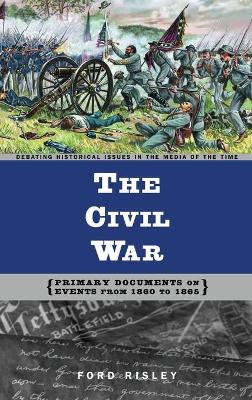
The Civil War: Primary Documents on Events from 1860 to 1865
(Hardback)
Publishing Details
The Civil War: Primary Documents on Events from 1860 to 1865
By (Author) Ford Risley
Bloomsbury Publishing PLC
Greenwood Press
30th October 2004
United States
Classifications
General
Non Fiction
Civil wars
Early modern warfare (including gunpowder warfare)
973.7
Physical Properties
Hardback
336
Width 156mm, Height 235mm
652g
Description
Read how the most pressing issues of the Civil War were argued over, shaped, and regarded by Americans north and south. News articles, editorials, and cartoons from the time offer a range of contentious and impassioned opinions and reports on the crucial events that precipitated, sustained, and eventually concluded this vital chapter in American history and politics. A startling mosaic of sentiment - often conflicting, always partisan, and much of it noble - emerges from the din of journalistic campaigning waged over the battle for public opinion on both sides of the Mason-Dixon line. Topical chapters offer multiple annotated documents related to twenty-four crucial topics and events occurring and debated during the "War Between the States". Questions designed to stimulate written and oral discussions conclude each chapter. A full index and bibliography conclude the work. Beginning with Lincoln's election in 1860 and concluding with his assassination in 1865, The Civil War offers clear examples of a wide range of opinion about military matters like the draft, the preparation for war, arming slaves, and the impact of the battles of Bull Run, Gettysburg, and Sherman's March to the Sea. Political issues are also strongly represented as editorials and articles reacting to the southern states' secession, civil liberties and elections in the Union and the Confederacy are presented in equal measure. A strong and valuable resource for students and researchers of this pivotal period of American history.
Reviews
[S]uitable for college classes in journalism or history.-Reference & Research Book News
Intended for use in the classroom, Ford Risley's The Civil War is a collection of short editorials related to twenty-seven of the most important topics of the Civil War, ranging from secession to Gettysburg. Chronologically, the collection covers the election of Lincoln through his assassination. The editorials come from both North and South and from major and little-known newspapers. Each section starts with a short topical introduction, includes ten to fifteen editorials, and concludes with bibliographic references and review questions. Risley's introduction provides valuable information about newspapers and their power in nineteenth-century America. The circulation, cost, and brief history of some of the major papers help highlight how important newspapers were during the Civil War. Risley also helps scholars by explaining the format and financing of 19th century papers.-H-Net: H-CivWar
The Civil War: Primary Documents on Events From 1860 to 1865 provides a cogent reminder that the opinions and attitudes surrounding the war between the states were much more complex and varied.... The main strength of the book lies in its reliance on primary sources. The selections demonstrate the broad range of opinions that circulated in communities large and small on both sides of the border. The editorials also offer vivid examples of the writing style of newspaper editorials in the mid-19th century. Far different from the more homogenized language used in newspapers today, the prose is often florid, sometimes eloquent and oratorical in its directness--or abusive and racist in tone. Finally, the selections offered in The Civil War constitute a rich documentary record of the thoughts and feelings--the structure of consciousness--that led men to war and kept them at it for five bloody years.-American Journalism
"Suitable for college classes in journalism or history."-Reference & Research Book News
"[S]uitable for college classes in journalism or history."-Reference & Research Book News
"Intended for use in the classroom, Ford Risley's The Civil War is a collection of short editorials related to twenty-seven of the most important topics of the Civil War, ranging from secession to Gettysburg. Chronologically, the collection covers the election of Lincoln through his assassination. The editorials come from both North and South and from major and little-known newspapers. Each section starts with a short topical introduction, includes ten to fifteen editorials, and concludes with bibliographic references and review questions. Risley's introduction provides valuable information about newspapers and their power in nineteenth-century America. The circulation, cost, and brief history of some of the major papers help highlight how important newspapers were during the Civil War. Risley also helps scholars by explaining the format and financing of 19th century papers."-H-Net: H-CivWar
"The Civil War: Primary Documents on Events From 1860 to 1865 provides a cogent reminder that the opinions and attitudes surrounding the war between the states were much more complex and varied.... The main strength of the book lies in its reliance on primary sources. The selections demonstrate the broad range of opinions that circulated in communities large and small on both sides of the border. The editorials also offer vivid examples of the writing style of newspaper editorials in the mid-19th century. Far different from the more homogenized language used in newspapers today, the prose is often florid, sometimes eloquent and oratorical in its directness--or abusive and racist in tone. Finally, the selections offered in The Civil War constitute a rich documentary record of the thoughts and feelings--the structure of consciousness--that led men to war and kept them at it for five bloody years."-American Journalism
Author Bio
FORD RISLEY associate professor of communications and head of the Department of Journalism at Penn State. He is the author of articles on the antebellum and Civil War press and published in American Journalism, Civil War History, Georgia Historical Quarterly, and Jounralism History.
